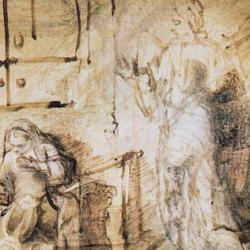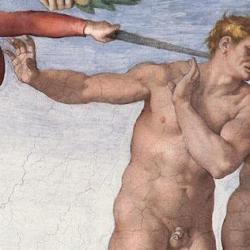John Bergsma and Scott Hahn offer a compelling defense of a “maternal incest” view of the story of Noah’s nakedness in Genesis 9 (JBL 124:1). They reject a “voyeurist” interpretation of the story. They find more to recommend a “paternal incest” view of the story, pointing to the parallels between Gen 9 and Gen 19 (incest of Lot and daughters); the sexual connotations of “uncover” and “nakedness” elsewhere in the OT; the sexual associations of wine and vineyard (including in Gen 19).
Ultimately, they reject the paternal incest view (ie, that Ham sodomized his father) for a maternal incest view (ie, that Ham had sex with his mother). Their reasons are as follows:
1) The language of “uncover nakedness” is not used in Leviticus to describe homosexual incest but heterosexual incest.
2) Specifically, the “nakedness of the father” is identified with the “nakedness of your mother” (Lev 18:7-8).
3) If this is about Ham’s incestuous sex with his mother, the emphasis on Canaan comes clear. Canaan is, on this interpretation, the product of the incestuous union, as Moab and Ammon are the product of Lot and his daughters. That is why Canaan is cursed, and why the text consistently identifies Ham as the “father of Canaan.” They suggest that the narrative has been compressed, and that the curse was actually pronounced at Canaan’s birth rather that immediately after the incest. If the incest was homosexual, it is difficult to explain how the curse would be placed on a son.
4) The material incest interpretation better shows the connections of Gen 9 with Gen 6, 19, Lev 18 and 20, Dt 23:1, 27:30, not to mention the maternal incest of Reuben. Genesis shows that the chief enemies of Israel – Canaan, Moab, Ammon – are all of questionable heritage.
5) This interpretation preserves the idea (articulated by Jim Jordan among others) that the story is about an attempted seizure of Noah’s authority. Bergsma and Hahn quote a 1971 article from FW Basset: “A son who has sexual relations with his mother or step-modern commits a rebellious act against his father, since the possession of a man’s wife is seen also as an effort to supplant the man himself.” They note the connection with Absalom, Reuben, David’s taking Saul’s wives, Adonijah’s attempt to have Abishag.
6) They suggest that “the tent” in v 21 “appears to have the feminine possessive suffix,” though “the MT points the word according to the qere,” ie, as “his tent.” Thus, one might read the text as saying that Noah entered “her tent,” the tent of Mrs Noah.
Their final reconstruction: Noah “becomes drunk”; this is disputed by Jordan, and there’s no reason to make this a part of the story. He goes into his wife’s tent and removes his robe to have sex with his wife, but “is incapacitated by his drunkenness” – again, not necessary to the story; Noah could well have had a vigorous roll before he fell asleep. The rest of the reconstruction is plausible: “Ham enters and ‘sees his father’s nakednness,’ that is, engages in relations with his father’s wife (v. 22a). He exits and informs his brothers of his grasp at familial power (v. 22b), perhaps producing an article of clothing as proof of his claim. The brothers, in turn, act with excessive filial deference and piety in returning ‘the garment’ . . . to their humiliated father, avoiding not only the figurative ‘seeing of his father’s nakedness’ (i.e., maternal incest) but the literal as well. In the aftermath of the event, Noah curses the product of Ham’s illicit union, namely, Canaan, and blesses Shem and Japheth for their piety” (pp. 38-39).
The value of this interpretation is severalfold: It brings Gen 9 into conformity with other passages that employ the “uncover nakedness” language; it preserves the fact that Ham assaults Noah’s authority; it links up with a recurring theme of Gen – the patriarch who escapes a judgment (Noah, Lot, Jacob?) finds himself under assault from his son; it helps to explain the curse on Canaan; it links together Canaanite, Moabite, and Ammonite in their origins, thus explaining the links between these peoples later in biblical history.











